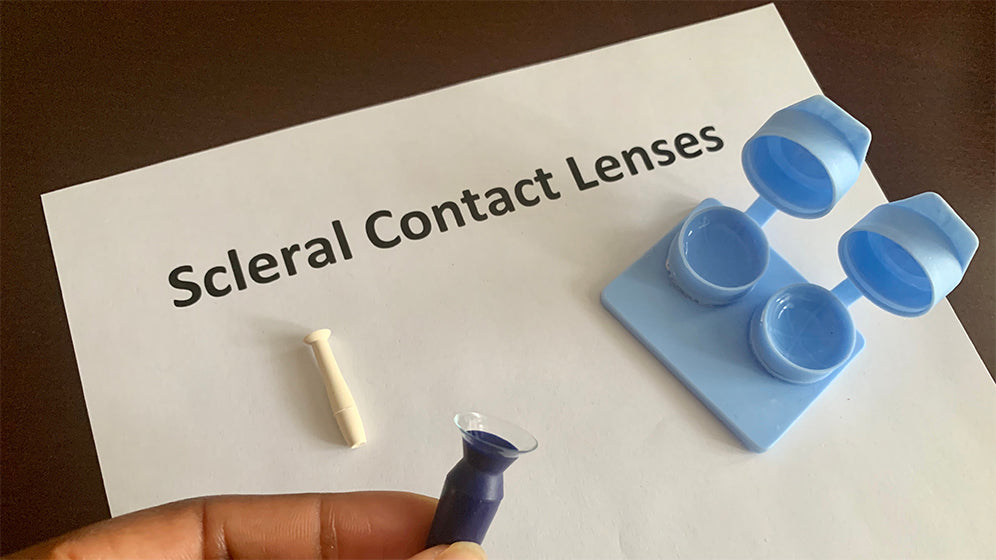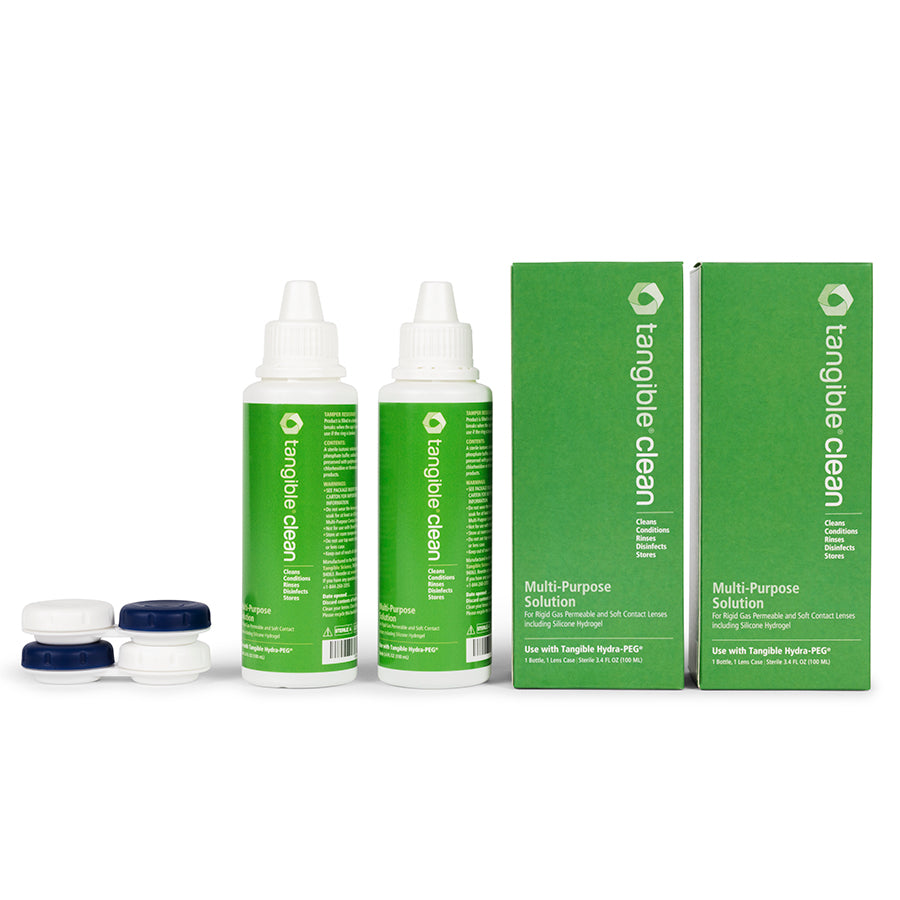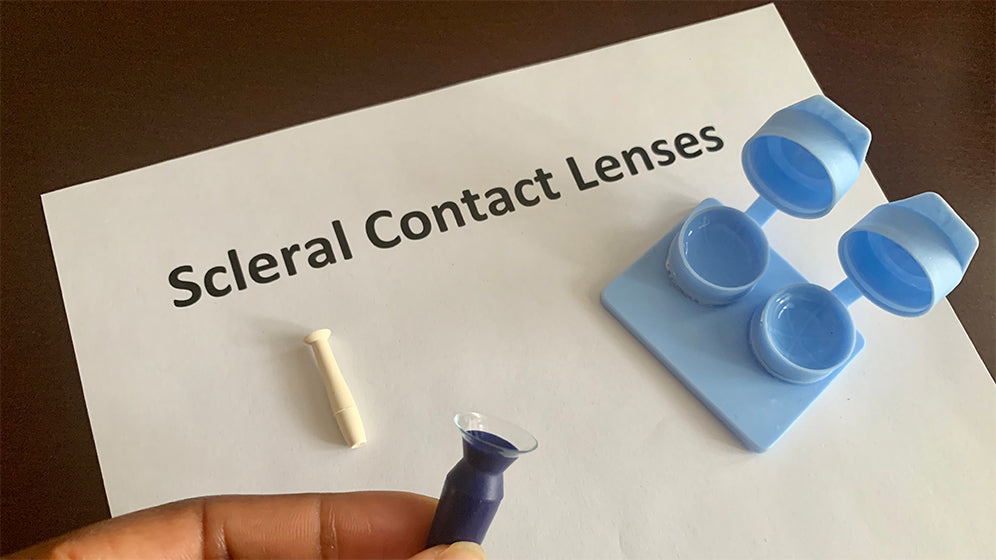Your cart is empty
Already have an account? Log in to check out faster.

Struggling with scleral lens care? You're not alone. This ultimate guide is your one-stop resource for everything you need to know about maintaining your scleral lenses for long-lasting comfort and clarity.

Scleral lenses are specialized contact lenses primarily prescribed for patients with keratoconus, dry eyes, or other corneal conditions. These rigid, gas-permeable lenses have a wide diameter, allowing them to vault over the entire corneal surface and rest on the sclera, the "white of the eye." This unique design offers unparalleled comfort and effective vision correction.
Inserting and removing scleral lenses can be daunting initially. But don't worry, with a bit of practice, you'll become an expert in no time. Here's a step-by-step guide to help you master the technique.
1) Wash hands with a non-fragrant and non-moisturizing soap. Dry thoroughly.
2) Remove the lens from your case, and rinse if preferred.
3) Place the lens, centered, on the inserter tool.
4) Fill the lens with preservative-free saline solution making sure to overfill the bowl.
5) Secure the upper and lower lids open.
5) Look down with your chin to your chest. Apply the lens by raising the lens inserter toward your eye while looking into the center of the lens. Keep both eyes open.
6) When you feel the solution touching your eye and overflowing from the lens, hold it there with only minimal pressure.
7) Pull the inserter away, ensuring the lens stays on your eye.
8) Raise your head, and let go of your bottom lid first, then the top lid. The top lid is heavier and will come down with more force. Releasing the lower lid first will help to ensure the lens is in place
9) Check for bubbles by paying close attention to how the lens feels. If the lens is uncomfortable, it may be due to an air bubble trapped beneath the lens. Remove the lens and repeat the application.
1) Wet the tip of the remover before placing it on the lens (you can use a drop of your Tangible Clean, Saline, or rewetting drop.
2) Face a mirror and open your lids with your fingers.
3) Place the head of the remover at 6:00 on the lens with slight to moderate pressure to secure it to the lens.
4) Rotate the lens by moving the remover left and right several times. This will help to release the seal that was made upon insertion.
5) Pull up and away with gentle pressure. Avoid “dragging” the lens across the eye.
6) Remove the lens from the remover device by sliding it off.
7) Dry the remover and store it in a clean, dry place.
Proper care of scleral lenses is crucial to your success. When lenses are not in your eyes, they should typically be stored wet due to surface treatments, including the Hydra-PEG coating. Use only approved and recommended cleaning solutions, not all solutions are appropriate for all lenses. Use only preservative-free saline solution. Saline should be used only to insert and rinse as needed. Do not store lenses in saline solution. Never use tap water to rinse your lenses.
For more care tips specific to combating scleral lens discomfort, check out our 12 tips to avoid scleral lens discomfort.
Clean your contact lens case with your disinfectant solution and wipe dry with a lint-free cloth. Store it upside down with the lids off until the next use. Contaminated contact lens cases have been linked to rare but serious eye infections. The CDC recommends replacing contact lens cases monthly.
Multipurpose solutions clean, rinse and disinfect with a single product. They are also appropriate for storage.
Place your scleral lens in the palm of your hand. Place a drop of Tangible Clean or your approved multipurpose solution on the lens and rub each side of the lens gently for 10 seconds.
Rinse the lens with Tangible Clean or your approved multipurpose solution. Place the lens in the proper well of the case and fill the case with Tangible Clean or your approved multipurpose solution. Store for 6 hours or overnight.
Peroxide solutions can be used to clean and disinfect your scleral lenses. This type of solution works by gently breaking up debris on the lens. The peroxide is neutralized to saline by a catalyst disc in the case. This neutralization process takes 6 hours.
Place your scleral lens in the proper side of the barrel case. Do not rinse the lens first. Fill the barrel case to the indicator line with the peroxide solution. Leave at least 6 hours for full neutralization of the peroxide to saline. After 6 hours, you may wear your lenses. Some patients prefer to rinse their lenses in Tangible Clean or an approved multipurpose solution before wear.
TIPS:
If you must remove the lenses before 6 hours, rinse them very well before inserting them!
Never place your peroxide solution directly into your eye.
Keep a multipurpose solution on hand for rinsing and storing your lenses for less than 6 hours.
Keeping your scleral lenses clean and free of build up is key for successful wear. It is important to use solutions that have been approved for your specific lens type. Using a non-compatible solution could harm your scleral lenses.
Your practitioner will typically recommend a cleaning system for you that will consist of a multipurpose solution, a peroxide solution, or a combination of the two. They will consider things such as allergies, corneal sensitivities, previous history with contact lens solutions, and even convenience to you, the patient.
Both Peroxide and Multipurpose Solutions clean and disinfect your lenses very well. If your practitioner allows you to choose a cleaning system for yourself, here are the main points to consider to compare them.

Tangible Clean is an ultra thin contact lens solution that gives you a more refreshing cleaning experience. Less residue on the lens means more comfort and less irritation. If you prefer the convenience of a multipurpose solution or your practitioner has recommended it, read more and order Tangible Clean here: https://tangiblescience.com/products/tangible-clean
Clear Care is by far the most popular peroxide system available in the US. It has two formulations and both are compatible with scleral lenses and with the Hydra-PEG coating.
Scleral lenses should be filled with preservative-free saline only. This is because there is longer contact time with the cornea. Saline solutions that are indicated for scleral lenses are preferred.
Scleral saline can come in buffered, or non-buffered options.
Buffered saline maintains a stable pH closely matching your natural tears. This is accomplished by the solution’s fixed pH level, which mimics the natural tear. Many scleral lens wearers find this promotes a more comfortable wearing experience. On the other hand, buffers create a challenge for the natural tear to overcome and adjust as needed.
Non-buffered saline lacks the added chemicals, helping to maintain a more natural balance in the tears and allowing the body to instinctively adapt. Some patients may find the lack of additives beneficial, while others may prefer the fixed pH of buffered saline. Non-buffered saline can be more cost-effective.
For more information on the differences between buffered and non-buffered saline, check out our comprehensive article here: https://tangiblescience.com/blogs/contact-lens-resource-hub/scleral-saline-to-buffer-or-not-to-buffer
Did you know? We recently added Tangible Fill to our innovative family of products. This FDA-approved unbuffered scleral filling and rinsing solution rounds out the Tangible system and works harmoniously with Tangible Hydra-PEG, Clean, and Boost.

Rewetting drops are plentiful, to say the least! So how do you know which one is right for you?
First, ask your practitioner if they have a recommendation. Most practitioners recommend their scleral lens patients use a preservative-free drop. You can not overuse rewetting drops. Moist lenses always perform better than dry lenses, so habitually using a drop throughout the day can actually improve your wearing experience.
TIP: Not all drops that state they are approved for contact lenses are preservative-free. Look for “preservative-free” or “PF” on the box, even if it does not indicate it is approved for contact lenses.
Disclaimer: To ensure long lasting eye health and contact lens comfort, always report any new symptoms or challenges to your eye care practitioner.


If you're experiencing discomfort with your scleral lenses, initiating a discussion with your Eye Care Provider is essential. It may seem... Read more

Now that you have made it home with your scleral lenses, it’s time to care for them. Pretty simple, right?... Read more

Struggling with scleral lens care? You're not alone. This ultimate guide is your one-stop resource for everything you need to... Read more

If you're experiencing discomfort with your scleral lenses, initiating a discussion with your Eye Care Provider is essential. It may seem... Read more

Now that you have made it home with your scleral lenses, it’s time to care for them. Pretty simple, right?... Read more

Struggling with scleral lens care? You're not alone. This ultimate guide is your one-stop resource for everything you need to... Read more
Stay up to date on the top scleral and RGP lens tips from our expert, NCLE certified staff.